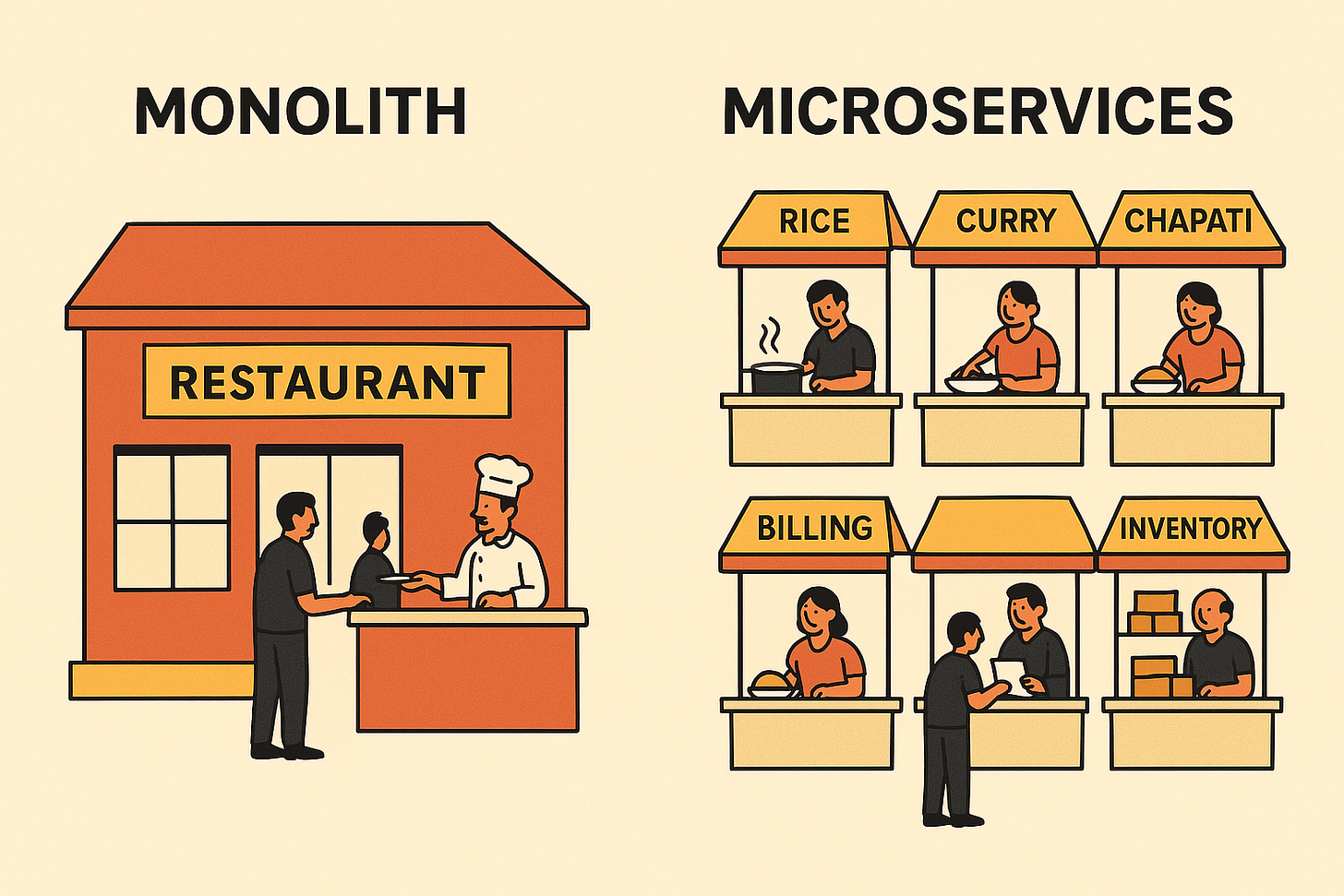Monoliths Might Scale Better Than Microservices — The Truth Nobody Tells You
Well-designed monolith often scales better, is faster, cheaper, easier
Modern engineering culture worships microservices.
Diagrams, Kubernetes clusters, API gateways, sidecars, service meshes…
It feels like if you are not deploying 50 microservices, you are not “scaling”.
But in the real world?
Most applications do not need microservices.
In fact, a well-designed monolith often scales better, is faster, cheaper, easier to debug, and far more stable.
Let’s go deeper — with a real analogy, and C# examples — to understand why.
The Real-World Analogy: One Restaurant vs 12 Tiny Stalls
Imagine you run a restaurant.
Monolith = One big restaurant
One kitchen
One chef team
One billing counter
One cleaning team
One inventory room
All staff coordinate easily. Information flows instantly. Customers get food fast.
Now imagine this is the same restaurant re-designed as microservices.
Microservices = 12 food stalls
Rice stall
Curry stall
Chapati stall
Dessert stall
Billing stall
Token stall
Inventory stall
Each stall has its own:
Staff
Billing pattern
Queue
Workflow
Communication challenges
A customer wants a full meal?
They must visit all stalls and coordinate everything through tokens, scanners, and loudspeakers (APIs).
It looks scalable from outside, but it actually increases:
Wait time
Coordination failures
Running cost
Latency between stalls
Integration headaches
This is exactly what microservices do when applied prematurely.
Why Monoliths Often Scale Better
Because internal calls are faster than network calls
Inside a monolith:
A method calls another method in memory → nanoseconds.
In microservices:
Service A → network → gateway → load balancer → service B → deserialize → process → serialize → response.
Each call costs:
Network latency
Serialization/deserialization
Timeout handling
Retries
Load balancing
Logging
Distributed tracing
A single user action may trigger 12 network hops.
In a monolith, the same action is just function calls.
C# Example: Simple monolith call
public class OrderService
{
private readonly PaymentService _payment;
public OrderService(PaymentService payment)
{
_payment = payment;
}
public string PlaceOrder()
{
var result = _payment.Process(”12345”);
return “Order Completed: “ + result;
}
}
Everything happens in-memory.
Fast, reliable, simple.
C# Example: Same thing in Microservices (Costly Network Call)
public class OrderService
{
private readonly HttpClient _http;
public OrderService(HttpClient http)
{
_http = http;
}
public async Task<string> PlaceOrderAsync()
{
var response = await _http.GetAsync(
“https://paymentservice/api/pay/12345”
);
var result = await response.Content.ReadAsStringAsync();
return “Order Completed: “ + result;
}
}
Now you must handle:
timeout
retries
circuit breakers
API versioning
scaling across clusters
authentication tokens
distributed logs
tracing (Zipkin, Jaeger)
And this is just one call.
Multiply this by 50 services.
Now it’s a nightmare.
Monoliths Scale Really Well When Designed Correctly
Horizontal Scaling
Monoliths can run on multiple instances behind a load balancer.
Example:
App Server 1
App Server 2
App Server 3
They share:
the same codebase
the same behavior
the same deployment
This is much simpler than managing 50 microservices, each with its own deployment pipeline.
C# Scaling Example: Using Task-Based Concurrency
Monoliths can scale internally using .NET’s concurrency features.
public async Task ProcessOrdersAsync(IEnumerable<Order> orders)
{
var tasks = orders.Select(order =>
Task.Run(() => ProcessSingleOrder(order))
);
await Task.WhenAll(tasks);
}
This uses:
multi-threading
async operations
parallel workloads
No network calls. No queues. No distributed sync.
Why Startups & Mid-Sized Companies Should Prefer Monoliths
Less Infrastructure
Microservices demand:
Gateway
Docker
Kubernetes
Service mesh
API version manager
CI/CD per service
Observability suite
Message queues
Monolith?
One application
One build pipeline
One deployment
Clean. Simple. Inexpensive.
You Still Can Add Modules Inside a Monolith (Best of Both Worlds)
The monolith doesn’t need to be spaghetti code.
You can structure it using modules:
/Modules
/Orders
/Billing
/Inventory
/Payments
With domain boundaries using Clean Architecture.
C# Example:
public interface IPaymentProcessor
{
string Pay(int amount);
}
public class RazorPayProcessor : IPaymentProcessor
{
public string Pay(int amount) => $”Paid {amount} via RazorPay”;
}
public class PaymentModule
{
private readonly IPaymentProcessor _processor;
public PaymentModule(IPaymentProcessor processor)
{
_processor = processor;
}
public string HandlePayment(int amount) => _processor.Pay(amount);
}
You continue to maintain boundaries inside a single codebase.
This is modular monolith architecture — the best of both worlds.
When Should You Actually Move to Microservices?
Only after the monolith hits these limits:
Deployment of one module breaks another
Teams are large (80+ developers across multiple domains)
Individual modules require different scaling patterns
Certain modules need independent release cycles
You need polyglot technologies
Cloud billing demands cost separation
You reached true business complexity
At this stage, microservices make sense.
Microservices Are Not Bad — Just Not Meant for Everything
Microservices solve problems of:
huge organizations
massive traffic
distributed teams
domain specialization
independent deployments
But for 80% of products, monoliths:
scale better
cost less
reduce latency
avoid complexities
ease debugging
improve developer productivity
Final Thought
Monoliths are not old-fashioned.
They are underrated.
Modern systems must be built based on business needs — not fashion trends.
If your app is still growing, still evolving, still experimenting…
then a monolith is your best companion.
Because nothing scales better than simplicity.


